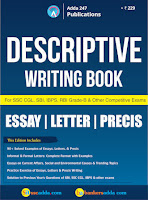Dear Students,
Numerical Ability for SBI Clerk Prelims 2018
Today is the Day 13 of the SBI Clerk 60 Days Study Plan and the topic for Today’s Numerical Ability Practice Questions is Time, Speed and Distance. Numerical Ability Section has given heebie-jeebies to the aspirants when they appear for a banking examination. As the level of every other section is only getting complex and convoluted, there is no doubt that this section, too, makes your blood run cold. The questions asked in this section are calculative and very time-consuming. But once dealt with proper strategy, speed, and accuracy, this section can get you the maximum marks in the examination. Following is the Numerical Ability quiz to help you practice with the best of latest pattern questions.
Q1. In covering a certain distance, the speeds of A and B are in the ratio of 3 : 4. If A takes 20 minutes more than B to reach the destination, the time taken by A to reach the destination is:
(a) 5/4 hours
(b) 4/3 hours
(c) 2 hours
(d) 5/2 hours
(e) 3 hours
Q2. A is twice as fast as B and B is thrice as fast as C. The journey covered by C in 54 minutes will be covered by B in:
(a) 18 minutes
(b) 27 minutes
(c) 38 minutes
(d) 9 minutes
(e) 13 minutes
Q3. A boy walks from his house to school at 2.5 kmph and arrives 12 minutes late. The next day he walks at 4 kmph and reaches the school 15 minutes earlier. What is the distance from his house to school?
(a) 3 km
(b) 4.5 km
(c) 5 km
(d) 6.5 km
(e) 7.5 km
Q4. A car travels first half distance between two places with a speed of 40 kmph and the rest of the half distance with a speed of 60 kmph. The average speed of the car is:
(a) 48 kmph
(b) 37 kmph
(c) 44 kmph
(d) 46 kmph
(e) None of these
Q5. Excluding stoppages, the speed of a bus is 54 kmph and including stoppages, it is 45 kmph. For how many minutes does the bus stop per hour?
(a) 12
(b) 10
(c) 9
(d) 20
(e) 25
Q6. A man goes uphill with an average speed of 24 kmph and comes down with an average speed of 36 kmph. The distance travelled in both the cases being the same, the average speed for the entire journey is:
(a) 30 kmph
(b) 28.8 kmph
(c) 32.6 kmph
(d) 42 kmph
(e) 45 kmph
Q7. Two cyclists start from the same place. One goes towards North at 12 kmph and the other goes towards East 16 kmph. What time will they take to be 10 km apart?
(a) 9/4 hours
(b) 30 minutes
(c) 60 minutes
(d) 93/4 minutes
(e) 35/3 minutes
Q8. R and S start walking towards each other at 10 am at speeds of 3 kmph and 4 kmph respectively. They were initially 17.5 km apart. At what time do they meet?
(a) 2 : 30 pm
(b) 11 : 30 pm
(c) 1 : 30 pm
(d) 12 : 30 pm
(e) None of these
Q9. A train travels a distance of 600 km at a constant speed. If the speed of the train is increased by 5 km/hr, the journey would take 4 hrs less. Find the speed of the train.
(a) 100 km/hr
(b) 25 km/hr
(c) 50 km/hr
(d) 75 km/hr
(e) 80 km/hr
Q10. Walking at the rate of 4 km per hour, a man covers a certain distance in 3 hours 45 minutes. If he covers the same distance on cycle, at the rate of 16.5 kmph, the time taken by him is:
(a) 58.45 minutes
(b) 54.54 minutes
(c) 52.44 minutes
(d) 45.55 minutes
(e) 56.56 minutes
Q11. A certain distance is covered at a certain speed. If half of this distance is covered in double the time, the ratio of the two speeds is:
(a) 1 : 2
(b) 4 : 1
(c) 1 : 4
(d) 2 : 1
(e) 3 : 5
Q12. ‘A’ walks at a uniform rate 4 km per hour and 4 hours after his start, B bicycles after him at the uniform rate of 10 km an hour. How far from the starting point will be catch A?
(a) 16.7 km
(b) 18.6 km
(c) 21.5 km
(d) 26.67 km
(e) 23.23 km
Q13. A car completes a journey in 10 hours. If it covers half of the journey at 40 kmph and the remaining half at 60 kmph, the distance covered by car is:
(a) 400 km
(b) 480 km
(c) 380 km
(d) 300 km
(e) 350 km
Q14. Vipin can walk a certain distance in 52 days when he rests 10 hour a day. How long will he takes for twice the distance, if he walks twice as fast and rests twice as long each day?
(a) 104 days
(b) 26 days
(c) 78 days
(d) 182 days
(e) 124 days
Q15. Two trains pass each other on parallel lines. Each train is 100 metres long. When they are going in the same direction, the faster one takes 60 seconds to pass the other completely. If they are going in opposite directions they pass each other completely in 10 seconds. Find the speed of the slower train in km/hr.
(a) 30 km/hr
(b) 42 km/hr
(c) 48 km/hr
(d) 60 km/hr
(e) 56 km/hr
(a) 5/4 hours
(b) 4/3 hours
(c) 2 hours
(d) 5/2 hours
(e) 3 hours
Q2. A is twice as fast as B and B is thrice as fast as C. The journey covered by C in 54 minutes will be covered by B in:
(a) 18 minutes
(b) 27 minutes
(c) 38 minutes
(d) 9 minutes
(e) 13 minutes
Q3. A boy walks from his house to school at 2.5 kmph and arrives 12 minutes late. The next day he walks at 4 kmph and reaches the school 15 minutes earlier. What is the distance from his house to school?
(a) 3 km
(b) 4.5 km
(c) 5 km
(d) 6.5 km
(e) 7.5 km
Q4. A car travels first half distance between two places with a speed of 40 kmph and the rest of the half distance with a speed of 60 kmph. The average speed of the car is:
(a) 48 kmph
(b) 37 kmph
(c) 44 kmph
(d) 46 kmph
(e) None of these
Q5. Excluding stoppages, the speed of a bus is 54 kmph and including stoppages, it is 45 kmph. For how many minutes does the bus stop per hour?
(a) 12
(b) 10
(c) 9
(d) 20
(e) 25
Q6. A man goes uphill with an average speed of 24 kmph and comes down with an average speed of 36 kmph. The distance travelled in both the cases being the same, the average speed for the entire journey is:
(a) 30 kmph
(b) 28.8 kmph
(c) 32.6 kmph
(d) 42 kmph
(e) 45 kmph
Q7. Two cyclists start from the same place. One goes towards North at 12 kmph and the other goes towards East 16 kmph. What time will they take to be 10 km apart?
(a) 9/4 hours
(b) 30 minutes
(c) 60 minutes
(d) 93/4 minutes
(e) 35/3 minutes
Q8. R and S start walking towards each other at 10 am at speeds of 3 kmph and 4 kmph respectively. They were initially 17.5 km apart. At what time do they meet?
(a) 2 : 30 pm
(b) 11 : 30 pm
(c) 1 : 30 pm
(d) 12 : 30 pm
(e) None of these
Q9. A train travels a distance of 600 km at a constant speed. If the speed of the train is increased by 5 km/hr, the journey would take 4 hrs less. Find the speed of the train.
(a) 100 km/hr
(b) 25 km/hr
(c) 50 km/hr
(d) 75 km/hr
(e) 80 km/hr
Q10. Walking at the rate of 4 km per hour, a man covers a certain distance in 3 hours 45 minutes. If he covers the same distance on cycle, at the rate of 16.5 kmph, the time taken by him is:
(a) 58.45 minutes
(b) 54.54 minutes
(c) 52.44 minutes
(d) 45.55 minutes
(e) 56.56 minutes
Q11. A certain distance is covered at a certain speed. If half of this distance is covered in double the time, the ratio of the two speeds is:
(a) 1 : 2
(b) 4 : 1
(c) 1 : 4
(d) 2 : 1
(e) 3 : 5
Q12. ‘A’ walks at a uniform rate 4 km per hour and 4 hours after his start, B bicycles after him at the uniform rate of 10 km an hour. How far from the starting point will be catch A?
(a) 16.7 km
(b) 18.6 km
(c) 21.5 km
(d) 26.67 km
(e) 23.23 km
Q13. A car completes a journey in 10 hours. If it covers half of the journey at 40 kmph and the remaining half at 60 kmph, the distance covered by car is:
(a) 400 km
(b) 480 km
(c) 380 km
(d) 300 km
(e) 350 km
Q14. Vipin can walk a certain distance in 52 days when he rests 10 hour a day. How long will he takes for twice the distance, if he walks twice as fast and rests twice as long each day?
(a) 104 days
(b) 26 days
(c) 78 days
(d) 182 days
(e) 124 days
Q15. Two trains pass each other on parallel lines. Each train is 100 metres long. When they are going in the same direction, the faster one takes 60 seconds to pass the other completely. If they are going in opposite directions they pass each other completely in 10 seconds. Find the speed of the slower train in km/hr.
(a) 30 km/hr
(b) 42 km/hr
(c) 48 km/hr
(d) 60 km/hr
(e) 56 km/hr





 Quantitative Aptitude Quiz For IDBI AM/E...
Quantitative Aptitude Quiz For IDBI AM/E...
 Quantitative Aptitude Quiz For IBPS RRB ...
Quantitative Aptitude Quiz For IBPS RRB ...




